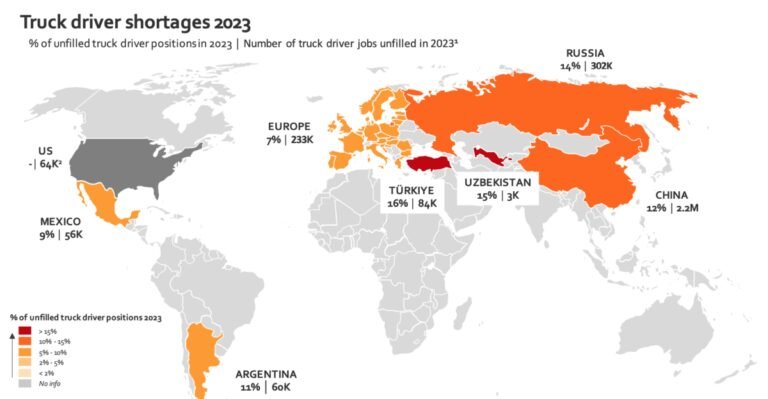The global shortage of truck drivers is expected to double by 2028 as age and gender gaps continue to grow wider, with just 12% of drivers under the age of 25 and just 6% women, according to a report by the Geneva-based International Road Transport Union (IRU).
The IRU found that the truck driver shortage has increased globally in 2023, with two notable exceptions: The shortage has eased slightly in 2023 in Europe and the United States, due to weak demand for transport as a result of inflation and tighter monetary policy that is limiting consumption and investment.
Without any measures to attract and retain drivers, more than 7 million truck drivers could remain unfilled by 2028 in the countries surveyed, including 4.9 million in China (20% of total jobs), 745,000 drivers in Europe (17% of total jobs) and 200,000 drivers in Turkey (28% of total jobs). The findings come from a survey of more than 4,700 trucking companies in the Americas, Asia and Europe, representing 72% of global GDP.
This situation is already affecting businesses, with at least 50% of ground transport operators reporting serious problems recruiting skilled drivers in most countries studied. Many are unable to expand their businesses and are losing existing customers and revenue.
“The structural issues behind the truck driver shortage continue to impact transport services. With the rate of new entrants significantly lower than the rate of driver retirements each year, urgent action is needed now,” ITU Secretary General Umberto de Pretto said in a statement.
“The consequences of this shortage are already hurting the communities, supply chains and economies that depend on our industry. We cannot allow the driver shortage to worsen. Operators are doing their part, but governments and authorities need to step up efforts to improve working conditions and access to the profession,” said De Pretto.
To address this gap, governments need to make the profession more accessible by lowering the minimum driving age and subsidizing training costs, according to the ITU. That’s because the school-to-driver gap is a major challenge facing the industry, with the minimum driving age for international freight transport stuck between 21 and 26 in some countries. High training, licensing and insurance costs also make it expensive to become a truck driver, the study said.





